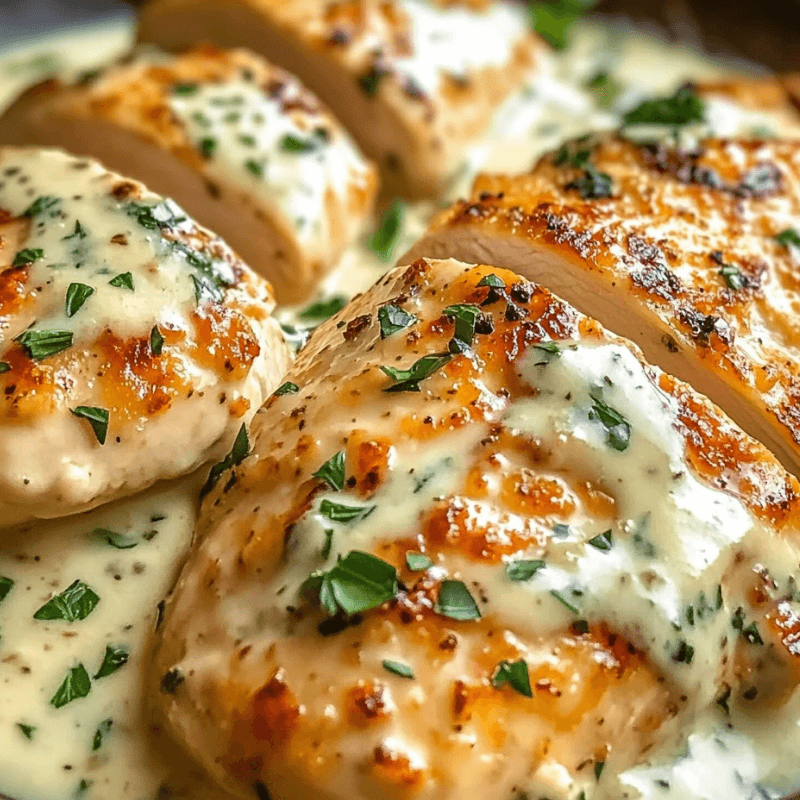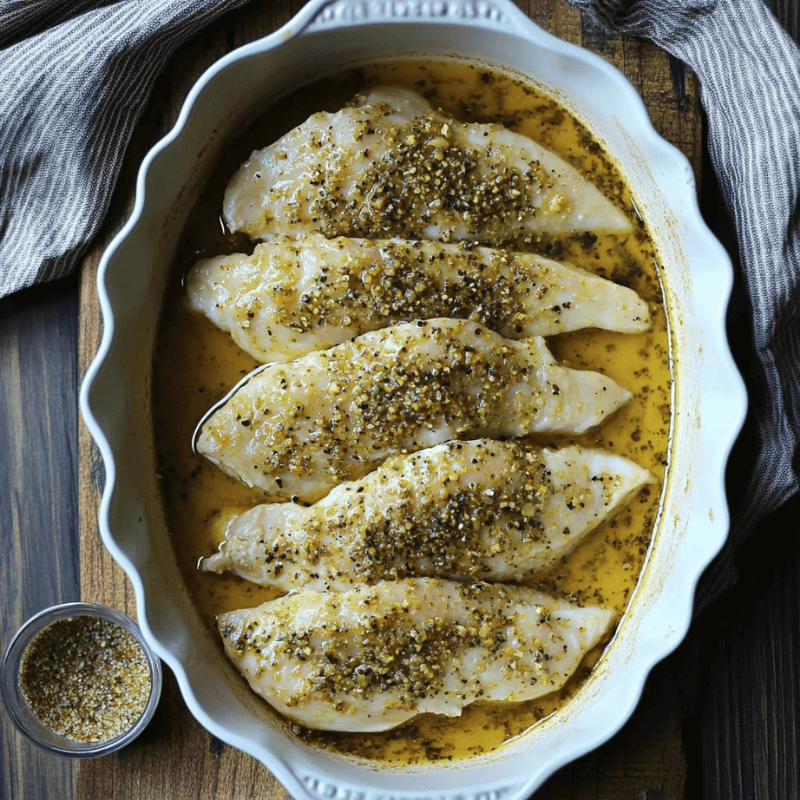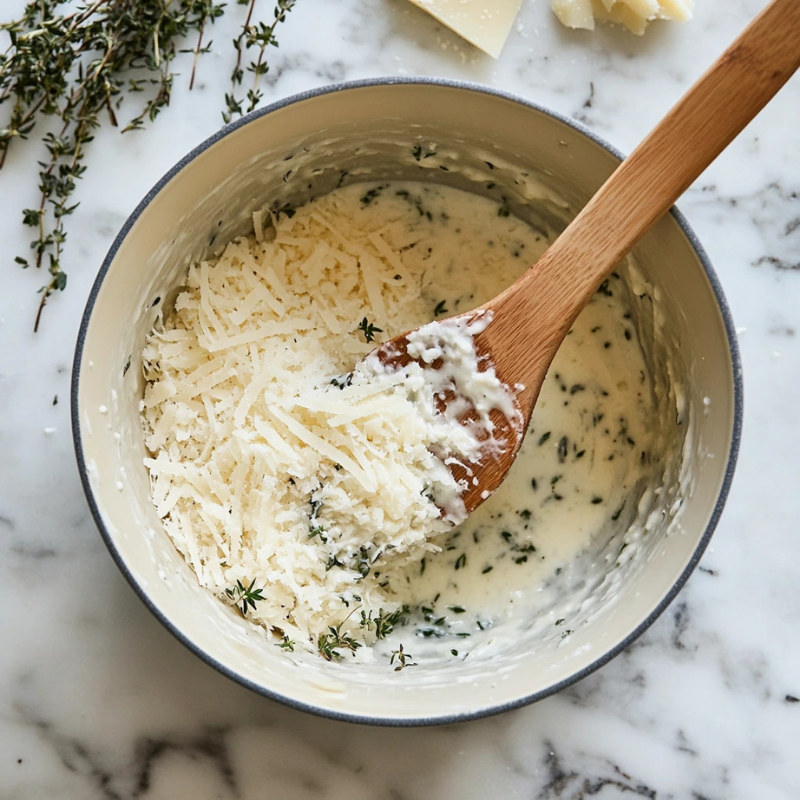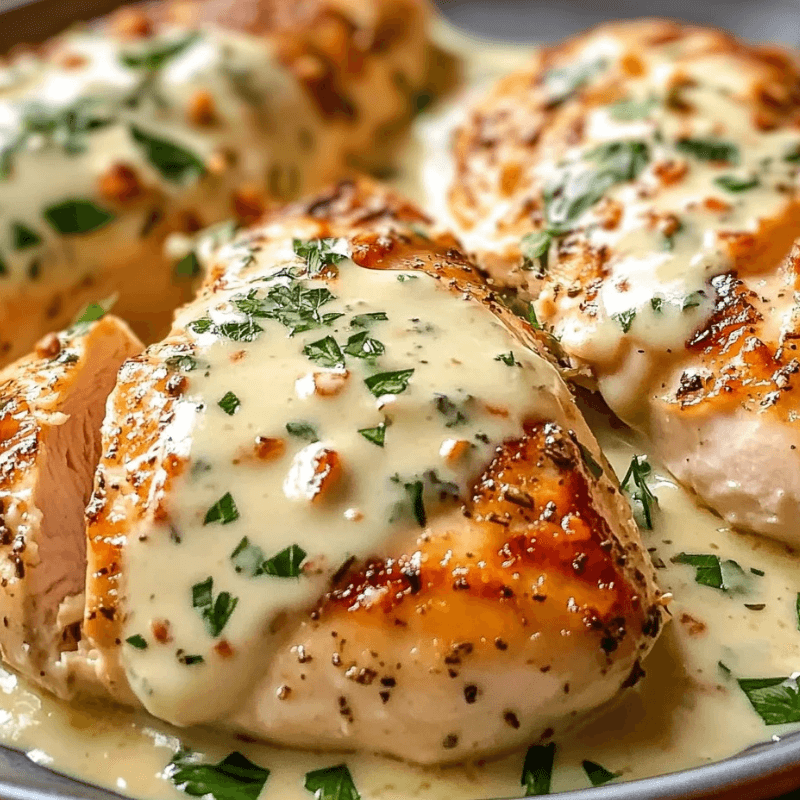This Melt In Your Mouth Caesar Chicken in your mouth and has amazed over 2,000 reviewers – and now I know exactly why. The magic happens with just 4 basic ingredients and takes nowhere near 30 minutes to prepare. Your kitchen becomes a restaurant as you create this crowd-favorite dish.
The recipe works perfectly for busy weeknight dinners or weekly meal preparation plans. Simple ingredients become something extraordinary when combined together. Tender chicken breasts blend with rich Caesar dressing and Parmesan cheese to create an irresistible texture that leaves plates empty. Let me guide you through the steps to achieve that perfect, Melt In Your Mouth Caesar Chicken result every time you make it.
The Science Behind Melt-In-Your-Mouth Chicken Texture
A bite of perfectly prepared Caesar chicken gives you that coveted Melt In Your Mouth Caesar Chicken texture. This isn’t just cooking magic—it’s pure science. The tender, juicy result comes from specific biological and chemical processes happening on your plate. Let’s look at what makes this chicken texture impossible to resist.
How protein breakdown creates tenderness
Chicken tenderness starts with its protein structure. Research shows that physical traits—particularly cohesiveness, springiness, and resilience—determine how chicken feels in your mouth. These qualities affect what scientists call “oral processing behavior,” which simply means how chicken breaks down as you chew.
Proteins in chicken muscle fibers start to denature and break down during cooking. This process turns tough, stringy raw chicken into tender, easy-to-chew bites. The transformation needs careful control because overcooking makes proteins contract too much, which forces out moisture and leaves you with dry, tough meat.
The perfect Melt In Your Mouth Caesar Chicken needs gradual protein breakdown. The best tenderness happens when muscle fibers soften but keep enough structure to hold moisture. This balanced breakdown gives you that perfect “falls apart with each bite” quality that makes everyone love this recipe.
The role of fat in juicy chicken
Fat content is a vital part of creating juicy chicken. Studies show that chicken with enough fat stays moist during cooking because fat works as a natural lubricant between muscle fibers. Dark meat naturally has more fat than white meat, which makes it juicier and more tender.
The science behind this juiciness involves two distinct feelings:
- Initial fluid release: The immediate wetness you see during first bites
- Sustained juiciness: The continued moisture sensation as you chew
Initial juiciness comes from water content, but sustained juiciness depends on fat, which gets your mouth watering as you eat. This explains why chicken with moderate marbling feels better—the finely spread fat lubricates muscle bundles while you chew.
High-quality chicken loses less moisture during cooking despite having more fat. This surprising finding suggests that fat creates structural changes that help hold water better, which stops chicken from drying out.
Why Caesar dressing tenderizes chicken
Caesar dressing doesn’t just add flavor—it changes the chicken’s texture completely. Its unique mix of ingredients tenderizes in multiple ways:
The acidic ingredients in Caesar dressing (like lemon juice and vinegar) start breaking down tough muscle fibers before cooking begins. This process works like a marinade to soften the protein structure.
The creamy mayo or oil base in Caesar dressing creates a protective layer that keeps moisture in while baking. Research shows this mayo coating “locks in moisture while adding a savory depth of flavor”, which prevents dry chicken.
Enzymes in the dressing mix with chicken proteins to create that signature tender result. Studies show that Caesar dressing combines with chicken juices during cooking to make “an absolutely delicious sauce” that makes eating even more enjoyable.
These processes work together to give Caesar chicken its amazing texture. The dressing adds “a nice richness and tenderness to the meat” and helps the outside brown perfectly—creating great contrast between outer and inner textures.
Caesar dressing works double duty as both marinade and cooking medium. The dressing’s mixed fats and proteins create the perfect environment for chicken to cook without drying out, giving you that signature melt-in-your-mouth Caesar chicken experience.
Essential Ingredients for Perfect Caesar Chicken
“This chicken recipe has minimal prep and requires only five simple ingredients.” — Donna John, Recipe Developer at 30Seconds
The secret to melt-in-your-mouth Caesar chicken starts with its ingredients. The right components make all the difference between an average meal and an amazing culinary experience. Here’s what you need to know about each part of this crowd-pleasing dish.
Selecting the right chicken cuts
Your chicken choice sets the stage for a Caesar masterpiece. Most people use boneless, skinless chicken breasts as their go-to option. These provide a lean, tender base that soaks up flavors beautifully. Chicken thighs and tenderloins are great alternatives too.
Each cut brings something special to the table:
- Chicken breasts turn out best when sliced or pounded into cutlets. This stops thick pieces from drying out.
- Chicken thighs give you more wiggle room while cooking because of their higher fat content. They’re more forgiving than breasts.
- Tenderloins cook faster and always come out tender.
The best results come from “butterflying” chicken breasts. This creates thin, even pieces that cook quickly and evenly. Whatever cut you pick, even thickness is key to that melt-in-your-mouth texture.
Choosing the best Caesar dressing
Caesar dressing plays two roles – it adds flavor and helps tenderize the meat. You want a dressing that balances creamy and tangy flavors with classic Caesar notes of garlic, lemon, and pepper.
You can’t go wrong with store-bought Caesar dressing. Many top chefs reach for avocado oil-based dressings. These offer clean flavors and better nutrition. A splash of milk helps the dressing coat your chicken more evenly.
Making your own? Mix mayonnaise, buttermilk, Parmesan, garlic, lemon juice, Dijon, and Worcestershire sauce for authentic Caesar flavor. Some cooks add sour cream to boost tanginess.
The importance of quality cheese
Parmesan isn’t just a topping – it’s crucial for authentic Caesar chicken. One chef puts it simply: “Would it even be Caesar without Parmesan? We think not”. This cheese brings the salty, savory depth that makes Caesar special.
Quality makes a huge difference. Block Parmesan beats pre-grated cheese in both flavor and melting. Parmigiano-Reggiano is the gold standard with its complex, aged flavor. Regular Parmesan works fine if you’re watching your budget.
How you grate matters too. A box grater’s coarse side creates perfect cheese pieces. A vegetable peeler gives you fancy shavings that look great and add texture.
Optional ingredients that improve flavor
These extra ingredients can turn simple Caesar chicken into something special:
- Seasonings: Mix lemon pepper, dried oregano, ground mustard, garlic powder, onion powder, and cayenne pepper for more complex flavors.
- Sour cream: Blend it with Caesar dressing for extra tang and creaminess.
- Nuts: Candied pecans add crunch and sweetness that balance the savory elements.
- Additional vegetables: Try cucumbers, celery, red onion, or cherry tomatoes for nutrition and texture.
This recipe works great with other proteins like shrimp, bacon, or thin-sliced steak. Plant-based versions with roasted chickpeas, sweet potatoes, and avocado taste just as good.
Pick your ingredients carefully and you’ll create Caesar chicken that melts in your mouth every time.
Chef’s Techniques for Foolproof Caesar Chicken
Every professional chef has their secret tricks that turn ordinary chicken into amazing meals. After trying countless methods, I’ve found that perfect melt-in-your-mouth caesar chicken needs exact preparation, the right thickness, and careful temperature control. Here are my game-changing techniques.
Proper chicken preparation methods
Your trip to perfect caesar chicken starts with preparation. Boneless, skinless chicken breasts work better than bone-in cuts. Two key steps will keep your chicken from drying out while cooking.
Put each chicken breast in a resealable plastic bag before pounding. This keeps meat from splattering and makes cleanup easier. Next, pat the chicken dry with paper towels before seasoning. This small step improves browning by a lot and helps the caesar dressing stick better to the surface.
You can keep your chicken juicy by covering your baking dish with foil during most of the cooking. This traps steam inside the dish and stops moisture loss. Your caesar chicken will stay tender even after long cooking times.
The ideal thickness for even cooking
Your chicken’s thickness will affect how well it cooks. Most failures happen because chicken isn’t evenly thick, leaving some parts overcooked while others stay raw.
Pound chicken breasts to a uniform ¾-1 inch thickness for best results. Thinner pieces (¼ to ½ inch) cook faster and more evenly—giving you that golden-brown outside while staying juicy inside. This even thickness lets the caesar dressing work its magic all through the meat.
Chefs agree that even thickness is a must for consistent results. This uniformity means the caesar flavor gets into every bite the same way—key to that signature melt-in-your-mouth taste.
Temperature control secrets
Temperature control is the most important yet overlooked part of perfect caesar chicken. Chefs know that internal temperature—not cooking time—shows when chicken is done.
To get it right every time:
- Use a good meat thermometer to check internal temperature
- Cook chicken to 165°F (74°C) for food safety
- Take chicken out at 150°F (65°C) and let it rest—it will finish cooking safely on its own
Thicker cuts do well with “low and slow” cooking. Keep heat at medium-low and let breasts cook through, flipping after about eight minutes. After baking, broil for 2-4 minutes to get that irresistible golden-brown top that makes caesar chicken look amazing.
The chicken keeps cooking after you take it off the heat. Bigger pieces heat up more than smaller ones, so knowing your cut size helps you pick the right time to remove it from heat.
Step-by-Step Caesar Chicken Recipe
“The chicken is dipped in the salad dressing, dredged in the panko, Parmesan and parsley flakes, and baked until golden, juicy and crispy. My husband said he didn’t even need a knife to cut the chicken it was so tender!” — Donna John, Recipe Developer at 30Seconds
This simple Caesar chicken recipe will reshape the scene of your dinner table by turning basic ingredients into an amazing meal. Let me show you how to create that signature melt-in-your-mouth texture that makes everyone love this dish.
Preparing the chicken
Start by heating your oven to 375-400°F. Thick chicken breasts need to be placed in a ziplock bag and pounded to an even ¾-1 inch thickness with a meat mallet or rolling pin. The uniform thickness helps cook the chicken evenly. Season both sides with salt and pepper. Adding garlic powder to your seasoning mix will boost the flavor.
Creating the perfect Caesar coating
The creamy Caesar dressing should be spread evenly across the bottom of a 9×13-inch baking dish. Place your seasoned chicken breasts on this layer. The remaining Caesar dressing goes over the chicken and covers each piece completely. A tangy twist comes from mixing the Caesar dressing with 2-3 tablespoons of sour cream before use.
Baking techniques for maximum juiciness
The baking dish needs foil cover for the first 10 minutes if you want to keep the moisture. The total baking time is about 20-25 minutes, and the chicken’s internal temperature should reach 165°F at its thickest part. The dish’s signature texture comes from proper timing – take it out right when it hits the safe temperature.
How to achieve the golden-brown finish
The final golden touch happens after the chicken cooks through. Switch your oven’s broiler to high. Each chicken breast should get an even sprinkle of grated Parmesan cheese. Place it under the broiler for 2-4 minutes until the cheese turns golden brown and melts. Keep a close eye since it can burn fast. The chicken needs 5 minutes to rest so the juices settle. A sprinkle of fresh chopped parsley gives it that restaurant-style look.
Troubleshooting Common Caesar Chicken Problems
Great cooks hit snags with caesar chicken too. I’ve made this recipe countless times and learned how to tackle the most common problems that might keep you from getting that perfect melt-in-your-mouth texture.
Fixing dry chicken
Overcooking leads to dry chicken. The best solution uses a meat thermometer—take the chicken out of the oven right when it hits 165°F (74°C). Your overcooked chicken isn’t hopeless! Let it rest under loose foil for 5-10 minutes so the juices spread through the meat.
Here are proven ways to keep your chicken moist:
- Let Caesar dressing shield your chicken’s moisture
- Cover your dish with foil during initial baking
- A loose foil cover helps if the top browns too fast
Note that the Caesar sauce acts as protection against drying out, which makes this recipe “completely and utterly fool proof” for juicy results.
Preventing sauce separation
Separated sauce can ruin your caesar chicken’s look and feel. Full-fat Caesar dressing prevents this issue—low-fat options have extra water that separates during baking.
A quick fix helps if your sauce breaks: add 1 tablespoon of all-purpose flour to the dressing/sour cream mix before it goes on the chicken. This binds everything together nicely.
Broken sauce during reheating? Warm it gently on low heat. Boiling will split your sauce instantly. You can also whisk in cool water one teaspoon at the time while heating until it becomes creamy again.
Adjusting cooking time for different ovens
Ovens cook differently. Size, heating elements, and climate affect cooking times. Look for visual hints instead of just following suggested times – your chicken should look golden brown.
The middle rack gives you the best results. Heat spreads evenly from this spot. Hot-running ovens need a 25-degree temperature drop. Cool ovens might need an extra 5-7 minutes of cooking time.
Solutions for uneven cooking
Chicken that’s both overcooked and undercooked usually means uneven thickness. The fix is straightforward: pound those chicken breasts until they’re ¾-1 inch thick.
Put your chicken in a ziplock bag on a flat surface and pound it with a meat mallet or rolling pin. This helps everything cook evenly and stay juicy. Place thicker parts toward the dish’s edges since oven heat concentrates in the middle.
Spotted some undercooked sections after baking? Don’t put the whole dish back. Just slice those parts and return them to the oven. This keeps your properly cooked chicken from drying out.
Conclusion
Caesar chicken looks simple on the surface, but you need to become skilled at creating that perfect Melt In Your Mouth Caesar Chicken. The right combination of science and technique makes this possible. You can create restaurant-quality results at home with the right ingredients, proper temperature control and careful preparation.
My kitchen experience points to three crucial elements for success. The chicken needs even thickness throughout. You must use high-quality Caesar dressing. The internal temperature requires close monitoring. While challenges might pop up, the fixes remain simple. Use full-fat dressing to prevent sauce separation and rely on a good meat thermometer to achieve perfect doneness.
Note that each preparation builds your expertise. You will develop an instinct for your oven’s unique characteristics and ideal timing. These foundational techniques serve as your starting point. Make adjustments based on your kitchen setup and priorities. Your Caesar chicken will soon turn out so tender that guests will think it came from a professional kitchen.
FAQs
Q1. What are the key ingredients for Caesar Chicken? The main ingredients for Caesar Chicken typically include chicken breasts, Caesar salad dressing, Parmesan cheese, and sometimes sour cream. These simple components work together to create a flavorful and tender dish.
Q2. How do I prevent my Caesar Chicken from drying out? To keep your Caesar Chicken moist, avoid overcooking. Use a meat thermometer to ensure the internal temperature reaches 165°F (74°C), then remove it from the oven. The Caesar dressing acts as a moisture shield, and covering the dish with foil for part of the cooking time can also help retain juiciness.
Q3. Can I use different cuts of chicken for this recipe? Yes, you can use various chicken cuts. While boneless, skinless chicken breasts are common, chicken thighs or tenderloins work well too. Thighs offer more forgiveness during cooking due to higher fat content, while tenderloins cook quickly and remain tender.
Q4. How can I achieve a golden-brown finish on my Caesar Chicken? To get that appealing golden-brown finish, sprinkle grated Parmesan cheese over the cooked chicken and place it under the broiler for 2-4 minutes. Watch closely to prevent burning. This step adds both visual appeal and a delicious crispy texture to the dish.
Q5. What’s the best way to season chicken for Caesar Chicken? While the Caesar dressing provides much of the flavor, you can enhance it by seasoning the chicken with salt, pepper, and garlic powder before applying the dressing. For a more complex flavor profile, consider adding dried herbs like basil and oregano, or a touch of paprika to your seasoning mix.

Welcome to HealthyBlog365, your go-to destination for all things food and drink. We believe that every meal is not just a way to nourish your body but also a meaningful connection with yourself and your loved ones.
HealthyBlog365 was created with a mission to inspire healthy living through nutritious meals and refreshing beverages. Here, you’ll discover a treasure trove of creative recipes, kitchen tips, and healthy eating trends tailored to fit modern lifestyles.
 What can you find on HealthyBlog365?
What can you find on HealthyBlog365?
- Delicious and easy-to-make recipes: From simple meals for busy mornings to wholesome dinners for family gatherings, we’ve got you covered for every occasion.
- Nutritious drinks: Explore recipes for juices, smoothies, detox teas, and drinks that cleanse your body, boost your mood, and energize your day.
- Guides on eating habits: Get detailed insights into popular diets like keto, low-carb, and vegetarian-friendly meal plans.
- Kitchen hacks: Discover smart tips to save time, preserve food, and cook more efficiently.
We are committed to providing high-quality content, staying up-to-date with the latest trends, and maintaining a balance between nutrition and flavor.
 Connect with HealthyBlog365 on Social Media
Connect with HealthyBlog365 on Social Media
Join the HealthyBlog365 community on social media platforms to stay updated with our latest posts, watch exciting tutorials, and share your food stories with us:
Facebook: Follow us here to stay updated with our latest posts and join our community.
Instagram: Check us out here for inspiring visuals and ideas.
Pinterest: Pin with us here to save creative ideas you’ll love.
YouTube: Subscribe here for detailed tutorials and exciting videos.
 Thank You for Supporting HealthyBlog365!
Thank You for Supporting HealthyBlog365!
We aim to build a connected community where everyone can share and learn from each other. If you have any questions or suggestions, don’t hesitate to reach out to us via social media or our website.
We hope you have a wonderful time on HealthyBlog365 and find new inspiration for your healthy culinary journey!
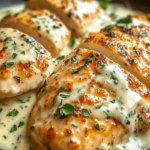
Melt in Your Mouth Caesar Chicken
Description
Ingredients
- 4 boneless skinless chicken breasts
- 1 cup Caesar salad dressing
- 1/2 cup sour cream
- 1 1/2 cups Parmesan cheese
- 1/2 teaspoon garlic powder
- Fresh parsley chopped, for serving
- Kosher salt and freshly ground black pepper to taste
Instructions
- Preheat the Oven
- Set your oven to 375°F (190°C). Lightly grease a baking dish to prevent sticking.
- Ezoic
- Prepare the Chicken
- Arrange the chicken breasts in the baking dish in a single layer.
- Make the Sauce
- In a mixing bowl, combine the Caesar dressing, Parmesan cheese, garlic powder, onion powder, oregano, basil, salt, and black pepper. Stir until well blended.
- Coat the Chicken
- Pour the dressing mixture over the chicken, ensuring each piece is evenly coated.
- Ezoic
- Bake the Chicken
- Place the dish in the oven and bake for 25-30 minutes, or until the internal temperature of the chicken reaches 165°F (74°C).
- Broil for a Golden Finish
- For a crispier, golden crust, turn the oven to broil and cook for an additional 2-3 minutes. Keep an eye on it to prevent burning.
- Garnish and Serve
- Sprinkle with fresh parsley before serving for a pop of color and freshness.

